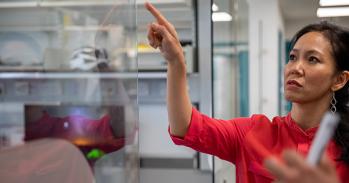
A book written for the general reader, Betrayed by Nature: The War on Cancer by Dr Robin Hesketh, sets out in plain English what goes wrong in our bodies when cells begin to replicate in an abnormal manner, and what science is doing to address the disease that kills seven million people every year.
A book written for the general reader, Betrayed by Nature: The War on Cancer by Dr Robin Hesketh, sets out in plain English what goes wrong in our bodies when cells begin to replicate in an abnormal manner, and what science is doing to address the disease that kills seven million people every year.
A new vista in medicine is opening up, one that for cancer has already identified the major driving mutations and thus provided focal points for the development of new drugs.
For 20 years or so Dr Robin Hesketh, Senior Lecturer in the Department of Biochemistry at Cambridge University, thought about writing a book. What he had in mind was one “that explained in the most simple way everything we think we know about cancer”. But he put it off, concentrating instead on experiments aimed at finding ways of stopping tumours growing and teaching Cambridge students about cells and how they signal to themselves and to each other. Then, one wet Sunday in 2008, he sat down at home and wrote the first words of Betrayed by Nature: The War on Cancer (Palgrave Macmillan, 2012).
Everything we think we know about cancer turns out to be quite a lot. We know that one in every three or four of us will get cancer during our lifetime – but that some of types can now be treated with very high success rates. We know that cancers are abnormal growths of cells – neoplasms – and that we’ve all got them in some form. Moles are unusual clumps of cells but are – almost always – unthreatening. We know that cancers can subvert our immune system, not only leaving us vulnerable to infection, but turning it from protector to traitor, giving succour to the neoplasm that can kill us. And we know that the lethality of these growths comes mainly from their acquiring the means to move home and, in wandering around the body, find a new locale in which to settle (a process known as metastasis).
Betrayed by Nature starts with a stroll through the history of cancer. As early as 1,600 BC the Egyptians were aware of conditions for which there was no treatment. Around 400 BC Hippocrates came up with the word carcinoma to describe tumours with a high density of blood vessels. Some 600 years later Galen, another Greek, is credited as the first person to use the word cancer (Latin for crab).
It wasn’t until the 18th century that physicians began to link cancers to occupation and lifestyle. In 1713 Bernardino Ramazzini noted that cervical cancer was rare in nuns yet they were prone to breast cancer. A few years later Percival Pott concluded that sweeps (many were boys who were sent up chimneys naked) developed cancer of the scrotum as a result of soot lodging in the folds of skin. And then in 1866 Paul Broca, having studied his wife’s family tree, became the first to suggest it might be possible to inherit breast cancer. Even before those observations, the 17th century pioneer Robert Hooke - a polymath whose inventive mind embraced physics, astronomy and the first blood transfusions - had identified the cell as the basic unit of life, laying the foundations for the field of cell biology.
Hesketh’s historical saunter leads us to the modern era of molecular biology. Launched by the revelation of the double helical structure of DNA in 1953, this field has seen an explosion of knowledge as the basic machinery of life has been unveiled. At its heart is the instruction code enshrined in DNA, in humans a sequence of three thousand million bases, and ‘DNA makes RNA makes protein’ has become ‘the central dogma’. With this has come the demonstration that thousands of diseases arise from corruptions in the code that are manifested in abnormal proteins. A well-known example is cystic fibrosis, an ultimately fatal condition caused by a mutant form of just one protein made in the lung.
Cancers too are mutation-driven diseases but with two crucial differences. The first is that cancers are driven by not one but several mutations acting in concert. As tumours develop they accumulate thousands of random mutations from which groups of perhaps half a dozen provide the driving force. The second is that the effect of ‘driver’ mutations is to cause cells to reproduce themselves abnormally. Many cells in the body replicate rapidly while some scarcely replicate at all after initial development is complete, and others can be ‘turned on’ when required, for example to repair injured tissue. The problem caused by cancer mutations is that they make cells multiply (in cell biology, multiplication is division) either too rapidly or at a time when, or in a place where, they shouldn’t.
Hesketh paints a picture of the infinity of flexible shapes that proteins can form and then illustrates the four major types of mutation that can act as cancer drivers. From this, the story moves to the effect of such mutants on the way cells behave – how normal cells are seduced into ignoring signals they should respond to, how cancer cells avoid suicide signals so that they survive with their mutant accelerators and defective brakes, adjusting their metabolism and co-opting nearby normal cells to promote their extravagant lifestyle, ensuring that survival and expansion of the tumour dominates. And then finally and fatally, we discover what happens when cancer cells spread in the usually fatal diaspora.
Betrayed by Nature addresses the unspoken question ‘if cancer is essentially so simple, how come it’s killing seven million people a year and the 12 million new cases in 2008 is set to become 15 million by 2020, when 30 million people on the planet will have cancer of some sort?’. Part of the answer is that we persist in doing things we know will get tumours going: sunbathing without protection (especially fair-skinned people), smoking (despite trends in some countries, the figure of over five million a year that tobacco use kills now, that’s one every six seconds, will rise to over eight million a year by 2030), eating poor diets and getting fat. On top of this, there’s the fact that we’re all living longer – and the longer we stick around, the more likely we are to develop cancer. In the Bronze Age the average lifespan was 18 years. Now world-wide it’s 66 and in the UK over 80 – facts that have the curious effect of making the cancer mortality rate in India (average life expectancy 64) half that of the UK.
The other – and more complicated – part of the answer lies in DNA and its extraordinary flexibility. The random game of chance is that life means that the odds are heavily against a fertilized egg making it into a human being. When it does so it will have encoded in its DNA millions of variants, not only making each of us different to one another (the basis of DNA ‘fingerprinting’) but also giving us an individual molecular canvas upon which the layering of subsequently acquired mutations will inevitably lead to cancer – if we live to be 140. The cancers that emerge are so highly individual that each is unique. Each tumour has a different genetic make-up, even though historically pathologists have classified them into distinct categories.
The astonishing individuality and complexity of each tumour is being revealed in molecular detail by current DNA sequencing methods and the final instalment of this saga is all about what Hesketh now regrets describing as “the greatest revolution in the history of medicine” in the book. He comments: “I should have substituted ‘science’ for ‘medicine’ because the technical advances that have occurred since the human genome was first sequenced in 2003 have already changed how we think about cancer and how we treat it and in the end they will affect everyone on earth.” The chapter ‘Let’s Sequence Your DNA’ notes that when the project to sequence the human genome was launched at the end of the 1980s the cost estimate was $1 per base: the current figure is one millionth of that—10,000 bases for one cent. The first sequencing machines in the early 1980s managed 10 kilo bases (10,000 bases) a day; the present rate is heading towards 100 million kb per day. So the cost has gone down by a factor of one million and the speed has gone up by 10 million.
All of this means that individual tumours can now be sequenced before treatment strategies are drawn up. For a number of the major cancers, sequencing has shown that tens of thousands of mutations accumulate as the tumours evolve in a process that Hesketh likens to ‘dynamic Darwinism’ as changes in DNA that confer a growth advantage permit clones to expand and dominate. The complexity of these mutational patterns is bewildering and it is almost beyond belief that a cell can survive such ferocious assaults on its genetic integrity, yet alone that a clone may emerge with the power ultimately to overwhelm its host.
A new vista in medicine is opening up, one that for cancer has already identified the major driving mutations and thus provided focal points for the development of new drugs. In parallel with the sequencing revolution, major strides are being made in ways of visualising tumours so that they can be detected with greater sensitivity and also that the effects of drug therapy may be followed. In addition, the progressive identification of molecular ‘biomarkers’ present in circulating blood will permit tumour detection at much earlier stages than is currently possible. These efforts are driven by the fact that surgery remains the first line of defence. More than 90% of cancer deaths come from metastasis. If they can be treated before they spread, by surgery and radiotherapy, the success rates are very high.
Amazing though the developments of the last ten years are, as is always the case in science, they build on what has gone before and Betrayed by Nature highlights the tremendous strides made in the second half of the 20th century. The pioneering work of Sidney Farber at Harvard in the 1940s produced remission of childhood leukemia. Since then other very effective treatments have evolved, as illustrated by the progressive rise in five year survival rates for breast cancer and prostate cancer to over 85% and almost 100%, respectively. One of the greatest triumphs has been the development of vaccines that are essentially 100% effective in preventing cervical carcinoma by blocking viral infection that is the cause of almost all these cancers.
The optimism in Betrayed by Nature derives from the evidence that the era we are entering offers not only the possibility of making an impact on cancers that have remained intractable but that, as detection is refined and the stock of specific drugs expands, we may even contemplate the replacement of surgery by highly effective chemotherapy. But Hesketh also has some simple messages that speak directly to today’s readers. “You can avoid a lot of things in life if you really want to: football, hamburgers, sex … but you can’t avoid cancer at least coming very close to you.” As for what we can do to maximise our chances of staying well, he says: “Don’t smoke – but if you do, give up – it’s not too late!” “Eat sensibly and do a bit of exercise” And he adds: “Men especially, if you think something’s wrong, follow JBS Haldane’s advice: don’t be macho – go and see your doctor.”
Betrayed by Nature: The War on Cancer by Robin Hesketh is published by Palgrave Macmillan, 2012.
This work is licensed under a Creative Commons Licence. If you use this content on your site please link back to this page.





